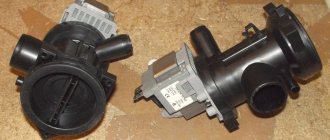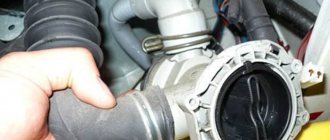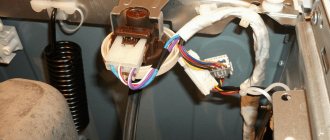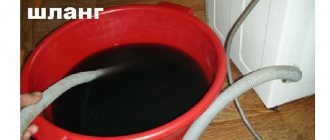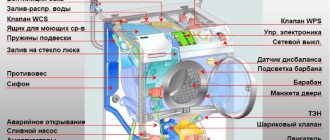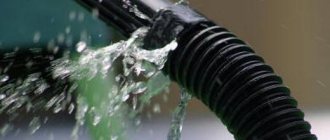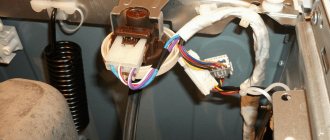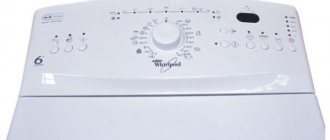In every modern apartment you can see an automatic washing machine in the kitchen or bathroom. Currently, manufacturers offer a huge number of different brands and models of washing units, which operate on the same principle, but are most often equipped with technological components of their own production.
Experienced craftsmen call the heart of the washing machine the drain pump, which ensures the normal functioning of the entire unit. Therefore, when a home assistant malfunctions, it is often necessary to know the types, classification and characteristics of pumps. Knowledge of the operating rules and features of caring for the washing machine pump will greatly extend the trouble-free service life of the entire unit.
Purpose
The washing machine pump performs one of the main functions in the correct and uninterrupted operation of the unit. The main role of using a drain pump is to remove dirty water from the washing machine tank. The entire washing cycle depends entirely on how this unit works, because the pump is involved in all washing modes (washing, rinsing, spinning and drying).
The need to periodically drain and collect water places a large load on the drain pump, so for trouble-free operation of the entire mechanism, you must follow the basic rules for operating the washing machine.
Drain pump device
Structurally, the drain pump (pump) for a washing machine is a low-power electric motor, on the shaft of which an impeller is mounted, which helps pump out used water.
The main components of the pump are:
- medium power electric motor;
- electric motor shaft;
- impeller;
- sealed casing in the form of a snail with two pipes.
One pipe of the housing is used to remove water from the washing machine tank, and the second is connected by a drain hose to the sewer.
Signs of a broken washing machine pump
If the machine is not operating correctly, before disassembling the drain system, you need to make sure that the fault is located in this exact location. It can be determined by several characteristics:
- The water drainage program has turned on, but the pumping system does not work;
- during draining, strong noises and buzzing are heard;
- water is pumped out, but flows out very slowly;
- during system operation, the machine may turn off;
- The pump motor hums, but no water comes out.
If one of these breakdowns is detected, we can say with a high degree of probability that the washing machine pump will have to be repaired.
Technical characteristics of the drain pump
The main characteristics of different models of washing machine drain pumps may vary depending on the power of the units.
Standard technical indicators are:
- productivity about 20 liters of water per minute;
- rated power of the electric motor is about 30 W;
- the motor winding has a resistance of about 160 Ohms;
- the ability to lift water up to a maximum of one meter;
- The water temperature should not be higher than 90 °C.
To protect the electric motor winding from overloads, a thermal relay is installed, which is designed to operate at a coil temperature of 150 °C.
Types of pumps
Currently, there are two types of drain pumps for washing machines:
1. The circulation pump is used mainly in premium washing units. Such a pump supplies washing liquid directly to the place of washing and produces forced circulation of water during the work process. Typically, a circulation pump is installed together with a simple drain pump that pumps out water. This design solution allows you to wash dirty laundry much more efficiently.
2. Cheaper models use an ordinary drain pump, which only removes liquid from the tank into the sewer system.
Also, drain pumps in different models of washing machines may differ in the shape of the volute and the type of filter that is located inside the housing.
Main malfunctions of the drain pump
During the washing process, the washing machine pump is switched on several times, depending on the selected mode. Therefore, a large load on the parts of this important unit is the main reason for pump failure.
Typical drain pump malfunctions are:
- frequent activation of thermal protection of the electric motor winding;
- clogging of the impeller, which leads to its jamming;
- damage to the impeller blades by foreign objects;
- premature wear of the bushings located on the motor shaft;
- the pump impeller rotates or falls off the electric motor shaft;
- short circuit or broken motor winding turns.
All these breakdowns lead to repair of the washing machine pump. Typically, repair work can be carried out after minor faults occur, such as clogged impellers, as well as minor damage to the blades. Other breakdowns lead to a complete replacement of the washing machine pump.
DIY drain pump repair
Repairs are carried out in parallel with checking the functioning of the main parts.
Sequencing:
- Determine whether there is excessive noise when the pump is operating.
- Find out if the filter and drain hose are clogged. The first one can be easily cleaned by hand if necessary. To clean the hose, remove it and place it under water so that the stream passes through it.
- Run the machine in rinse mode to check the operation of the pump. It is considered to be in good condition if water flows inside the tank at the required speed and an increased noise level is not generated during operation of the washing machine. If failures occur, proceed to the next step.
- Check that the impeller rotates correctly. To access it, you need to unscrew and remove the filter. The blades are rotated by hand to see how smoothly they rotate. If foreign objects or contamination are found, they must be removed.
Read more ► Replacing a bearing on a washing machine: step-by-step instructions on when to change
If the problem is not solved after taking the above measures, the washing machine is taken to a service center or to a private technician - most likely, the electronics of the unit have failed.
Replacing the pump through the bottom of the washing machine
The drain pump is located at the bottom of the unit, under the tank. Only it can be accessed through the bottom of the washing machine or after removing the front panel.
The pump for a Samsung washing machine is replaced through the bottom of the unit.
Instructions for dismantling the drain pump are as follows:
- Be sure to unplug the washing machine from the electrical outlet.
- Shut off the water supply before disassembling.
- Carefully place the washing machine on its side. In this case, the pump should be on top of the unit.
- Release the bottom of the machine from the lower protective panel. For this purpose, it is necessary to remove the fastening latches.
- If there is a plastic protective casing for the pump, this element must also be removed.
- Near the pump valve you will see screws securing the unit, which need to be unscrewed.
- Carefully pull the pump towards you.
- Then disconnect the pump power cables.
- Over a previously prepared container, so as not to spill the remaining water, loosen the hose clamps.
- If the pump has a volute, then you need to disconnect it too. In the future, if there are no complaints about this element, then after cleaning the snail can be left.
Installing a new or repaired pump is carried out in the reverse order.
A similar method is used to dismantle the pump in washing machines Indesit, LG, Beko and some other models.
The principle of operation of the pump, its application and location
During operation of the washing machine, water is supplied inside the device under pressure, that is, the intake occurs automatically as soon as the necessary programs are selected and the “START” button is pressed. The process then proceeds according to the following scenario:
- the solenoid valve is brought to the open position;
- a pressure switch (sensor for monitoring the liquid level in the tank) measures the required volume of water;
- the path of the liquid runs through the compartments where the necessary detergents (washing powder) are located, water mixes with them, and thus enters the tank in dissolved form;
- the liquid under pressure enters in the required volume into the chamber where the laundry is stored.
Related article: Pressure switch in a washing machine
During the process and completion of the wash, the water pump comes into play. It is he who drains and pumps out dirty waste liquid after washing or excess water after rinsing. The pump is involved in almost all washing modes!
As soon as a signal from the electronic module is sent to the pump, waste water will begin to be pumped into the sewer due to the impeller of the device. The fluid path is as follows:
Water enters through a rubber pipe, which is connected to the tank and volute using special clamps, then the liquid enters the pump through a special filter located in the volute, it protects the pump impeller from debris, to avoid jamming of the impeller. Next, the liquid comes out through the drain hose, which is connected to the volute. The dirty liquid phase is pumped out until the waste liquid is completely pumped out of the washing machine tank.
During washing, the water is already in the lower part of the unit, which is why the end of the drain hose must be secured above the drain pump, since if this is not observed, the water will begin to drain from the machine by gravity. The drain hose must be installed at least 80 cm along its entire length!
The electric drain pump is located at the bottom of the unit under the tank. It is attached to a plastic volute, usually with three screws, and the volute, in turn, is attached to the body of the unit from the front side. This arrangement is convenient for quick access to it, if, for example, you need to clean it of debris or drain liquid from the system.
There are two types of pumps used in washing machines:
- The circulation type of pump is used in conjunction with a conventional pump; they are used in new models of premium class machines such as Indesit, Ariston, etc. This option supplies water directly to the washing area and circulates throughout the system, which improves washing efficiency.
- machines from a more budget type or not of a new generation, such as the Daewoo bubble machine (Daewoo), are equipped with a simple pump, for example from Askoll, which simply drains the waste liquid into the sewer.
Repair of the drain pump of a washing machine, as a rule, is not carried out; most likely, spare parts in such devices will have to be replaced. That is, you will have to completely replace the broken pump with a new one.
ATTENTION! You can also inspect the device yourself for blockages or pump failure. But when inspecting the internal mechanism, you must first disconnect the equipment from electricity. Using a special device, such as a multi-mmmeter, check the contacts going to the pump and make sure there is no voltage, and only then continue working. All these precautions are necessary because the work is carried out near an open source of water.
Removing the pump through the front panel
Replacing the pump of a Bosch, Siemens and some other brands of washing machines is done after removing the front panel of the unit, since the bottom of such machines is closed.
Dismantling the drain pump is carried out as follows:
- First of all, you need to remove the top cover of the unit. To do this, you need to unscrew the mounting screws on the back of the machine, and then push the cover away from you from the front panel.
- The next step is to dismantle the control panel. For this purpose, remove the tray for washing powder and unscrew the screws securing the panel. After removing the screws, the panel is carefully placed on the top of the unit so as not to damage the connecting wires.
- Under the plastic protective panel there is a drain valve, which must be carefully removed above the container to drain the remaining water.
- Then you need to remove the sealing collar from the loading hatch.
- Thus, by dismantling the front panel, we will gain access to the pump.
- Having unscrewed the mounting screws of the pump and the front wall, you can begin to dismantle the pump.
- Having loosened the clamps on the pump nozzles, remove the connecting hoses.
After completing all these operations, we inspect the pump and impeller. In case of minor breakdowns, we clean the pump parts from contamination. Installing a new drain pump is done in the reverse order.
In top-loading washing machines, the pump is removed through the rear wall.
What can be done from an old pump?
A homemade water pump will replace manual labor - with a little tinkering, you will create an electromechanical device that will free you from the need to carry watering cans and buckets. However, it is not suitable for a large plot - the pump power is too small, but in a small garden it will be very useful. It is also suitable for supplying water to a fountain and for creating a backup water source so that your flowers are not left without watering if the main pump breaks down.
Related article: The drain in the washing machine does not work
What pumps are suitable?
To water the area, it is better to use pumps from old Soviet machines - only they are capable of dispensing up to 30 liters of water per hour. The pumps of new machines are not even capable of such a volume.
Pump operating rules
In order for any complex technical unit to reach its service life, you need to monitor its condition and follow some additional recommendations from the washing machine manufacturer:
- Before washing, check the pockets in your clothes to prevent small objects from getting into the rotating components of the unit.
- Use only a special detergent for automatic machines, which contains anti-scale additives.
- It is advisable to install a filter on the water supply system so that small particles of rust from the pipes do not get inside the machine.
- It is better to soak very dirty laundry before washing.
Remember that if signs of a problem with your washing machine appear, you must immediately begin to identify and repair the problem. It is easier to replace a failed drain pump than to replace the entire unit in the future.
